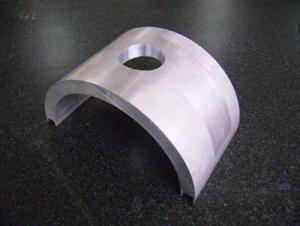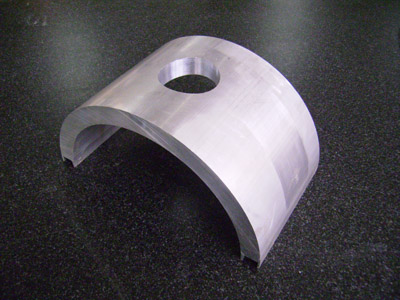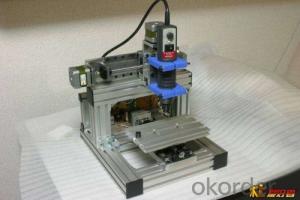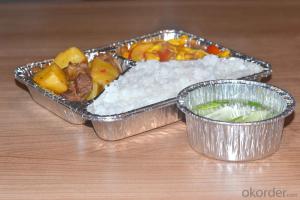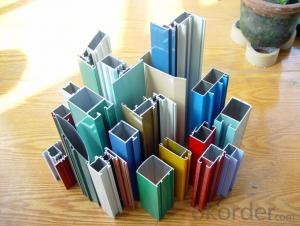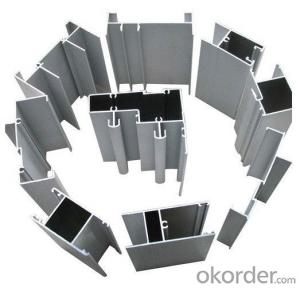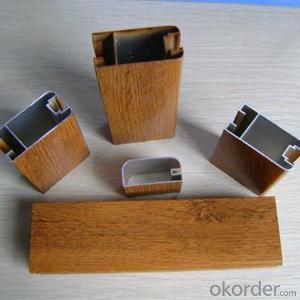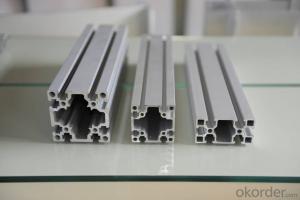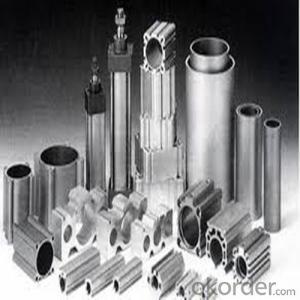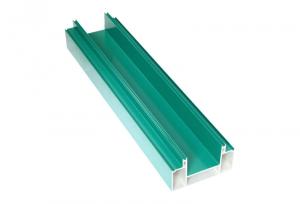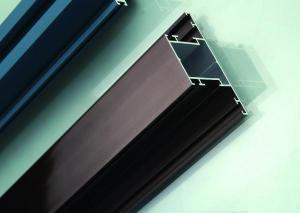China Made Extruded Aluminum Profiles
- Loading Port:
- China Main Port
- Payment Terms:
- TT OR LC
- Min Order Qty:
- -
- Supply Capability:
- -
OKorder Service Pledge
OKorder Financial Service
You Might Also Like
Aluminium Profile
Our advantages:
1)we can provide"one- stop service from melting,extruding,surface treatment,machining,welding,assembling to mould design & building.
2)we have a good capacity of precise machining,cnc machining.
3)we can provide good quality with reasonable price.
Products:
Description | Aluminium Profiles |
Alloy | Al 6063 T5 /T6 or 6061 or 6005 or as per customers' need |
Finish | Anodizing or powder coating with various colors |
Packing | Foam sheet,poly bag,plastic bag,carton |
Brand | YMJ |
Original place | |
Certificate | ISO9001 |
Equipments:
7extruders,2 six meters long anodizing lines,1 twelve meters long anodizing line(including dyeing & electrolysis).1 powder coating line,5 melting lines,12 CNCs(including 2 machines which can mill 6.5m long profile),10 argon arc welding machines and multiple machines for cutting,drilling,punching,milling,shearing and bending,2 spectrum scanners,1 projective instument,1 extension test machine,1 mechanical property tester,1 Rohs tester and 1 metallurgical microscope.
Service:
We're a well- established manufacture for aluminium products,we're confident we can give our customers complete satisfication.
We can provide good quality with reasonable price.
- Q: This question seeks to understand the various types of aluminum profiles that are specifically utilized in the construction of railings and fences.
- <p>Aluminum profiles for railings and fences come in various types, each designed for specific applications and aesthetic preferences. Common types include: 1) Rectangular profiles, which are versatile for both commercial and residential settings; 2) Square profiles, offering a modern look and are often used in minimalist designs; 3) Round profiles, providing a classic appearance suitable for traditional or vintage styles; 4) Slotted profiles, which allow for easy assembly and are popular for their adjustability; 5) Hollow profiles, known for their strength and lightness, ideal for high-load applications; 6) Angled profiles, used to create corners and intersections in railing and fence designs. Each type can be further customized in terms of size, thickness, and finish to meet specific project requirements.</p>
- Q: Is there any health risk linked to the use of aluminum profiles in construction?
- <p>There are minimal health risks associated with using aluminum profiles in construction. Aluminum is a non-toxic metal and does not emit harmful substances. However, during the manufacturing process, if not properly controlled, there might be exposure to dust or fumes which could be harmful if inhaled. Additionally, aluminum dust can cause skin irritation. It's important to handle aluminum profiles with care and use appropriate safety measures, such as wearing masks and gloves, to minimize any potential health risks.</p>
- Q: What is the HS code for aluminum profile?
- There are 76072000 aluminum foil backing76081000 pure aluminum tubeTubular Aluminum Alloy 76082010.099999994 cm diameter less than or equal to 10The other 76082010.900000006 aluminum alloy outer diameter less than 10 cm.76082099.099999994 outside diameter > 10 cm, other tubular aluminium alloy76082099.900000006 outside diameter > 10 cm, other alloy aluminium tube76090000 aluminum pipe fittings76101000 aluminum doors and windows and their frames, thresholds76109000 other aluminum structures and their components76110000 volume > 300 litre aluminium bin, pot and other containers76121000 aluminium hose container76129010 aluminum cans and cansThe store, tank 76129090 volume less than 300 liters76130010 retail packaging aluminium containers for compressed and liquefied gases76130090 non retail retail containers for compressed and liquefied gases76141000 strand aluminum stranded wire, cable, braid76149000 aluminium stranded wire, cable, braid without strip core76151900.099999994 aluminum pressure cooker76151900.900000006 other household utensils such as dining table and kitchen and their aluminium appliances76152000 aluminium sanitary ware and parts76161000 aluminum nails, screws, nuts, washers and other fastenersCloth, mesh, fence and grille 76169100 aluminum wire76169910.099999994 cylindrical solid aluminum alloy with a height of less than76169910.900000006 other industrial aluminum products76169990 other non industrial aluminum products84413010 plastic aluminum composite tank production equipment84418010 make paper plastic aluminum flexible packing equipment84552290.099999994 aluminum foil roughing mill85322210 piece aluminum electrolytic capacitor85322290 other aluminum electrolytic capacitors
- Q: What is the difference between the type 4040c and 4040d of aluminum profile?
- Sometimes there are differences in wall thickness, and sometimes there are differences between strengthening and non strengthening.
- Q: What are the features of the poor aluminum profiles?
- Poor quality aluminum profile:1, chemical composition unqualified, seriously endanger the safety of construction projects.2 、 profile corrosion resistance function is low.3, the film thickness is thin. The national standard rules of construction of aluminum oxide film thickness not less than 10um (m). The thickness is not enough, aluminum looks easy to rust and corrosion. Some no name and address, production license, certificate of inspection in the aluminum oxide film, the thickness of only 2 to 4um, some even without film.
- Q: How do aluminum profiles perform in terms of corrosion resistance?
- Aluminum profiles have excellent corrosion resistance due to the formation of a protective oxide layer on their surface. This oxide layer acts as a barrier, preventing further corrosion and making aluminum profiles highly resistant to rust and other forms of corrosion.
- Q: What role does glass curtain wall aluminum profile holder play?
- The subframe is formed by connecting the silicone structural adhesive with the glass and then connecting the plate with the aluminum alloy through the platen. The purpose of the subframe is to achieve the "hidden frame" purpose
- Q: What are the different installation methods for aluminum profiles?
- There are several different installation methods for aluminum profiles, depending on the specific application and requirements. 1. Screwed Installation: This is one of the most common methods for installing aluminum profiles. It involves using screws to attach the profiles to the desired surface. The profiles typically have pre-drilled holes to facilitate this process. Screwed installation provides a secure and stable connection, making it suitable for various applications. 2. Welded Installation: In some cases, aluminum profiles are welded together to create a strong and seamless joint. This method is commonly used in structural applications where high strength and rigidity are required. Welded installation can provide a more permanent and durable connection, but it requires specialized equipment and expertise. 3. Bolted Installation: Bolted installation involves using bolts and nuts to connect aluminum profiles. This method offers flexibility as it allows for easy disassembly and reassembly if needed. Bolted installation is commonly used in applications where frequent adjustments or modifications are required. 4. Adhesive Installation: Adhesive installation involves using specialized adhesives or bonding agents to attach aluminum profiles to the desired surface. This method is particularly useful when a seamless and aesthetically pleasing finish is desired, as it eliminates the need for visible screws or fasteners. Adhesive installation is commonly used in applications such as interior design, signage, and display systems. 5. Clamped Installation: Clamping is another method for installing aluminum profiles, especially in applications where a non-permanent connection is required. Clamps or brackets are used to secure the profiles in place, allowing for easy adjustment or removal. Clamped installation is commonly used in applications such as exhibition booths, temporary structures, or modular systems. It is important to consider the specific requirements of the project and consult with professionals or manufacturers to determine the most suitable installation method for aluminum profiles. Factors such as load-bearing capacity, aesthetics, ease of installation, and maintenance should be taken into account to ensure a successful installation.
- Q: Can aluminum profiles be used for stage and truss structures?
- Yes, aluminum profiles can be used for stage and truss structures. Aluminum is a lightweight, durable, and versatile material that is commonly used in construction and engineering applications, including stage and truss structures. It offers excellent strength-to-weight ratio, corrosion resistance, and ease of fabrication, making it an ideal choice for such purposes.
- Q: Are there any limitations or drawbacks of using aluminum profiles?
- There exist certain limitations and drawbacks when utilizing aluminum profiles. One constraint is its inferior strength in comparison to materials like steel. When it comes to demanding applications that necessitate high tensile strength or load-bearing capacity, aluminum profiles may not be the most suitable choice. In such circumstances, steel or alternative materials may be more preferable. Another disadvantage is that aluminum is more susceptible to corrosion when contrasted with materials such as stainless steel. Despite the possibility of applying protective coatings to aluminum profiles, they may still be prone to corrosion in harsh environments or if not adequately maintained. This can have an adverse impact on their durability and longevity. Furthermore, aluminum profiles may entail higher initial costs when compared to other materials. The production and processing of aluminum can be more expensive, which can affect the overall cost of incorporating aluminum profiles into construction or manufacturing projects. Lastly, aluminum profiles may have limitations concerning design flexibility. Although aluminum is relatively easy to shape and mold into different profiles, it may not possess the same versatility as certain other materials. This can restrict the range of options available for complex or intricate designs. Despite these limitations and drawbacks, aluminum profiles still offer numerous advantages, including lightweight construction, excellent thermal conductivity, and resistance to electrical conductivity. Therefore, it is crucial to thoroughly contemplate the specific requirements and constraints of a project before deciding to utilize aluminum profiles.
Send your message to us
China Made Extruded Aluminum Profiles
- Loading Port:
- China Main Port
- Payment Terms:
- TT OR LC
- Min Order Qty:
- -
- Supply Capability:
- -
OKorder Service Pledge
OKorder Financial Service
Similar products
Hot products
Hot Searches
Related keywords
